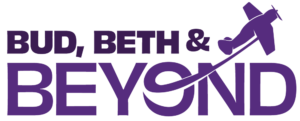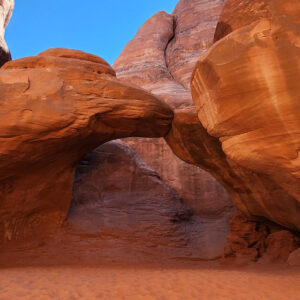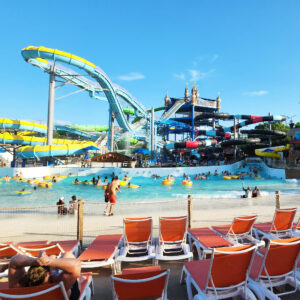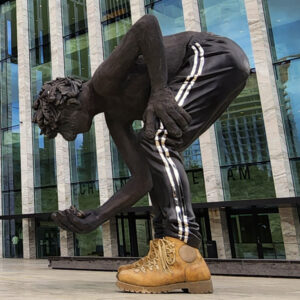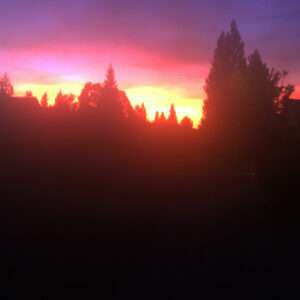Sitting halfway between San Antonio and Austin is a little town you’ve probably never heard of. New Braunfels, Texas was founded in 1845 by Prince Carl of Solms-Braunfels, an immigrant who named it after his hometown of Braunfels in Germany. The city boasts a population of about 100,000 people… unless you count the million people who visit its twin water parks each year.
Schlitterbahn may be ranked #4 for water park attendance in America, but it’s won Amusement Today‘s Golden Ticket Award for Best Water Park every year since the award was first introduced – 24 years ago! With more than 50 water rides scattered across 70 acres in two sister parks, it’s easy to see why Schlitterbahn is one of the top attractions in Texas.
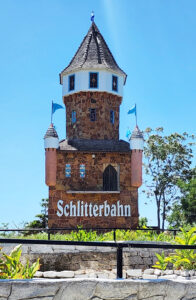
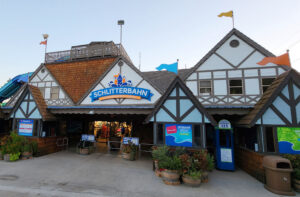
But it didn’t start out that way. In 1966, Bob and Billye Henry bought a crumbling resort located on thirteen acres along a spring-fed river in the countryside. Without TripAdvisor, TikTok, or Google AdWords, they needed a marketing gimmick to promote their fledgling business, and Bob had the perfect idea. In 1968, he built a body slide and an innertube chute to help his guests beat the Texas heat. The idea was just crazy enough to work, and it did. The two slides were popular, not just with resort guests, but with locals and other visitors too. So why not build more? The crowds would be thick as fleas on a farm dog…
In the summer of 1979, while Sony was promoting its new Walkman and millions of Americans were giving TLC to their pet rocks, the Henrys were fixin’ to open Schlitterbahn, a made-up name combining the German words Schlitter (“slippery”) and Bahn (“road”). Their park wasn’t big, with only four slides and twenty lifeguards, but it was new and instantly popular. The age of the modern water park had begun, but Texas being Texas, the Henrys had plans to be the biggest.
Schlitterbahn had been on my bucket list for years, so when my daughter Jenny and I went to Austin for a concert, a day trip to New Braunfels seemed like a no-brainer. We hit the road early and reached the park shortly after it opened on yet another hot summer morning. As we passed through the main gate, we were met with a panorama of color and the sounds of splashing water and laughter. Game on!
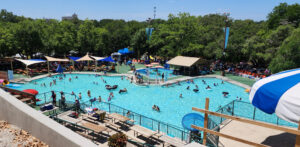
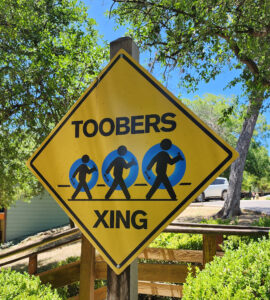
Downhill Racer, a 5 out of 5 on the park’s Thrill Level, was a great way to get our feet wet.
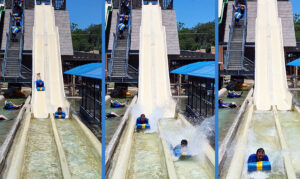
As I waited to enter the cleverly designed Soda Straws, I asked two pre-teens in line behind me if we shouldn’t be sliding up the straws rather than sliding down. “Isn’t that how straws work?” I asked. “That would be cool!” said the older one while the younger one bit her lower lip and said, “That sounds worse!”
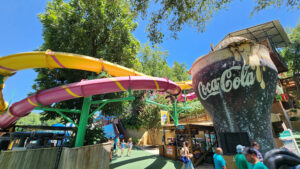
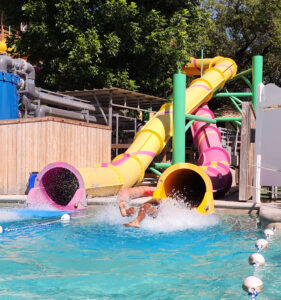
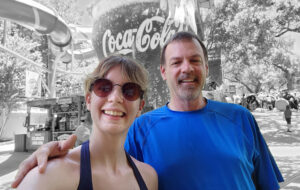
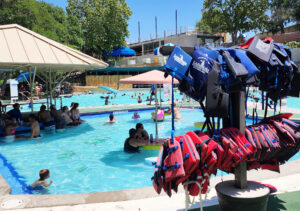
We tested Banzai Pipeline, Double Loop, Whitewater, and Cliffhanger. All super fun. There were plenty of attractions for the little kiddies too, including wading pools and lazy rivers.
Although Jenny and I wanted to focus on speed, we did slow things down a bit to risk the Congo River Expedition. For that ride, we’d each need an inner tube, which were safely caged up like prehistoric creatures in Jurassic Water Park. Luckily, Jenny found a few escaped specimens and wrangled what we needed. We survived the expedition, as the only wild animals we encountered were the ones floating in tubes all around us.
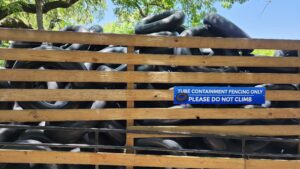
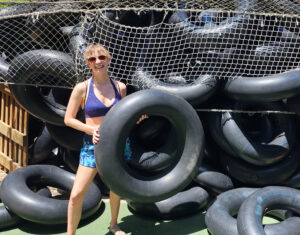
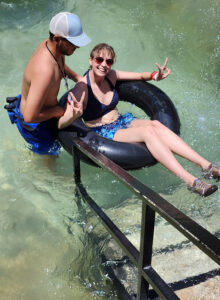
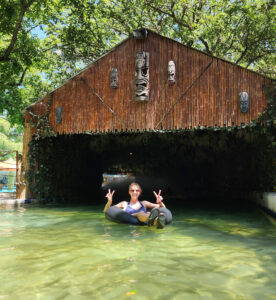
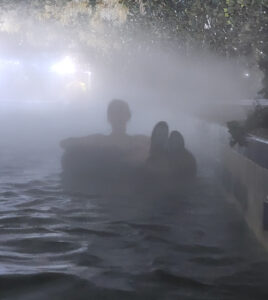
Unfortunately, I hadn’t done my research and didn’t realize that Schlitterbahn was really two separate parks connected not by a lazy river, but by shuttle bus.
The Henry family’s 1979 water park experiment had been an instant success, and they continued to add attractions throughout the 1980s until the acreage was nearly filled. With half a million annual visitors hungry for more and more excitement, Bob Henry bought a larger parcel of land three blocks away in 1991 and built Schlitterbahn East as a sister park featuring even edgier attractions.
Jenny and I had already spent two-thirds of our day at Schlitterbahn West enjoying the original attractions, but we were feeling the need… the need for speed. With state-of-the-art water coasters on our minds, we jumped on the shuttle bus to see more of what makes Schlitterbahn the “hottest, coolest time” in Texas. Both parks are included with a single admission, which beats the crap out of a trip to Anaheim where you pay separate fees for Disneyland and California Adventure.
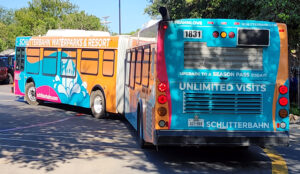
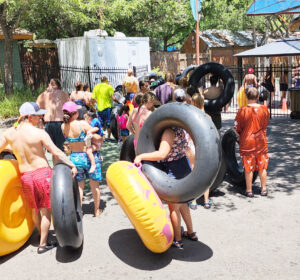
Schlitterbahn East features some breakthrough attractions. In 1992, it debuted Boogie Bahn, the world’s first inland surfing ride. Since I’ve never been a surfer, and the one time I tried wake boarding I had my hands ripped out of their sockets (it’s not proper anatomy, but that’s how it felt), I decided to enjoy the exciting attraction on my own terms: watching others while eating pizza.
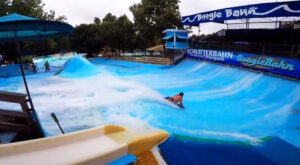
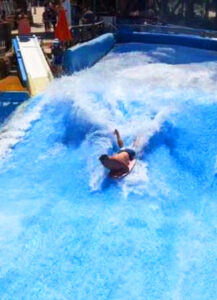
In 1994, Schlitterbahn introduced Dragon Blaster, the world’s first uphill water coaster. Updated with special effects and renamed Dragon’s Revenge, the ride is still a crowd pleaser. How can water run uphill? With a lot of pressure, let me tell you. Imagine sitting in an inner tube, then imagine a fire hose blasting you in the butt hard enough to knock you into next Tuesday. Yeah, that kind of pressure. Next thing you know, you’re uphill. Simple physics, perhaps, but totally weird science.
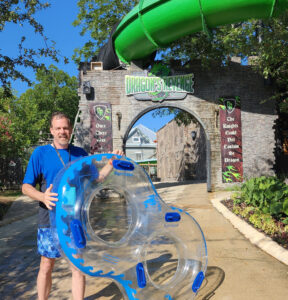
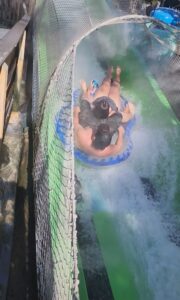
Next, we rode the Torrent River, introduced in 1996 as the world’s first wave river. Designed to deliver a natural river experience, there is nothing lazy about it.
In 2011, Schlitterbahn East added The Falls, the world’s longest tubing river, featuring rapids and tube chutes. The ride delivered as promised, giving us a nice long downhill trip through a good chunk of the park before taking us back up to where we started. This time, they didn’t use a fire hose to defy gravity. A wide conveyor belt dubbed “The Aquaveyor” pulled us up, up, up… I didn’t know what I’d find at the top, but seeing the monstrous gears churning alongside me, I hoped I wouldn’t end up as German sausage!
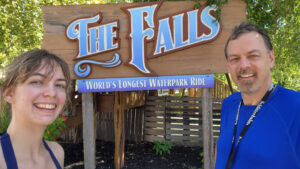
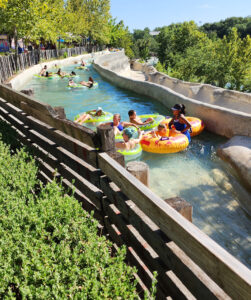
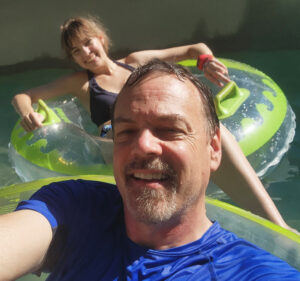
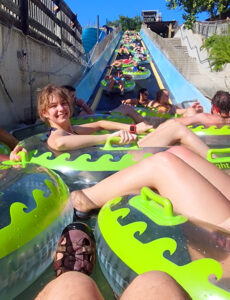
Water is a curious phenomenon; even when you have it perfectly manipulated, it can still ebb and flow and surge in unexpected ways. A couple times – on different rides – we found ourselves caught in invisible eddies that swirled us in circles while other riders passed us by. I left Jenny behind for several minutes at one point, unable to slow my progress as she struggled to get back into the main flow. We asked a worker if there was a trick to mastering the water, and she replied, “Sometimes there’s just nothing you can do about it.” Thanks for nothing.
There’s no way to do both parks in a day with a normal admission, especially on a hot day. That’s why Schlitterbahn offers the $45 Blast Pass and the $80 Super Blast Pass, which are add-ons to the $48 single-day admission price. Since New Braunfels was on our itinerary for only one day, we decided to Super-size our order with the $80 purchase. Who knows when or if we’d make it back?
The Super Blast Pass came with a waterproof watch that allowed us to make reservations – one ride at a time – for the most popular attractions. The pass cut our wait time in half and informed us when to show up at the front of the line, eliminating the need to wait in any line at all for the most part. Instead of spending 60 or 70 minutes in line, we could ride a less popular slide in the meantime and show up at our appointed time for a virtually non-existent wait. You can’t beat that with a stick.
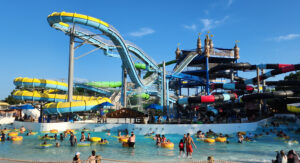
We finished the day with a few more thrill rides. Black Knight and Master Blaster started from new heights and finished with speeding, splashing finales. I can see why Master Blaster is the most award-winning uphill water coaster in the world, with wait times that can be as much as a couple hours during peak Summer days unless you have one of the Blast Passes.
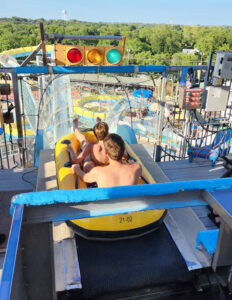
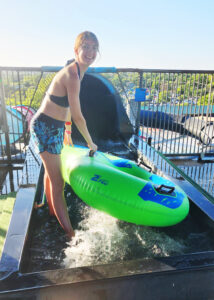
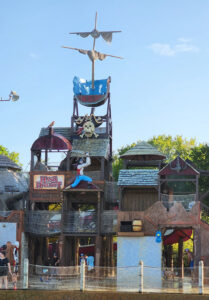
With rides like these, Schlitterbahn should increase their Thrill Level scale to 11! Even though we arrived shortly after the park opened and left only when they kicked us out at 8pm, we didn’t have time to ride everything. There’s simply too much to do. But, hey, it’s only 1,285 miles from Las Vegas to New Braunfels. Give me any excuse, and I just might find myself in the neighborhood again…

